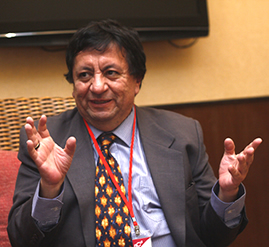Cloud Computing Technology Will In Future Help Elderly Living Alone

By Saiful Bahri Kamaruddin
Pix Izwan Azman
BANGI, 13 Nov 2013 – In the not too distant future, homes and buildings will use cloud computing technology to help elderly people who live alone and personalise education for individual children.
Professor of Applied Computer Vision at Kingston University in Britain, Professor Dr Sergio A Velastin said in twenty years time such technology can be made easy for ordinary people but powerful enough to detect the health of the occupants of houses and replace teachers or tutors at home.
Prof Velastin, who also lectures at Universidad de Santiago in Chile, said the smart technology can even be linked to the house, where cloud computing can do certain tasks for the occupants or remind the owners what they should do for the day.
Prof Velastin was in Malaysia to give a keynote address at the 3rd International Visual Informatics Conference organised by The National University of Malaysia (UKM).
In an interview with the UKM news portal, the Chilean-born researcher said in the case of a medical emergency, the system, which is on line, will give advice on what to do. If the owner is unconscious or disabled, it will contact emergency services.
An actual working system had been demonstrated in the United Kingdom recently as part of a research project using fibre-based sensors. The system may be limited for now, but eventually the homes which register for the service will be part of a huge network connected over the internet.
He said that such a system is necessary especially in Europe because hiring a full-time nurse or care-giver is becoming too expensive for most families.
The home-based system would also be advanced enough to become a companion to the house-bound occupants, in which they can actually talk with the network and interact with the computer.
Prof Velastin said at the same time, it will be commonplace for people to talk and interact with friends, business associates and seek advice from consultants from around the world through 3-D images that are so life-like you would think they are actually present.
It will be easy and economical to communicate with one another even over great distances via a digital cloud network using three-dimensional imagery interfaces and avatars.
He said networks carrying the communications processes may be made to be intelligent enough to advice users who to contact and who to avoid, based on data from previous interactions.
An avatar is an incarnation, embodiment or manifestation of a person or idea. In computer technology, an avatar is an image that presents a person when communicating with others. The image could be the actual real-time capture or something else completely different devised by the user.
Cloud network is a combination of computing processes such as digital processing, communications and storage of data that are on separate external servers all over the world which are not on the users’ personal devices.
An example is that of the smart devices which already exists, such as the internet refrigerator that can detect which food is in short supply and then inform the owner accordingly.
He explained that in the near future, we might be able to have devices that can automatically place an order to a retailer for provisions needed in the house and pay the bills as well.
The concept can be extended to education, in which communications, artificial intelligence and digital imaging can be brought together to personalise teaching to a particular individual – even children who are alone.
Prof Velastin is a visiting professor of the School of Computing and Information Systems, Kingston University in Britain.
He is generally acknowledged to be a leading authority in the field of digital imaging, smart notion and the analysis of human behavioural images in crowded situations.
He is also co-founder and Consultant at Ipsotek Ltd , a company that provides consultancy services for human monitoring using computer vision technology.
His current research interests are on automatic human detection especially in cluttered conditions, action recognition (eg for surveillance, assisted living, human-machine interaction), road traffic monitoring and embedded systems for image processing and computer vision.
![]()
